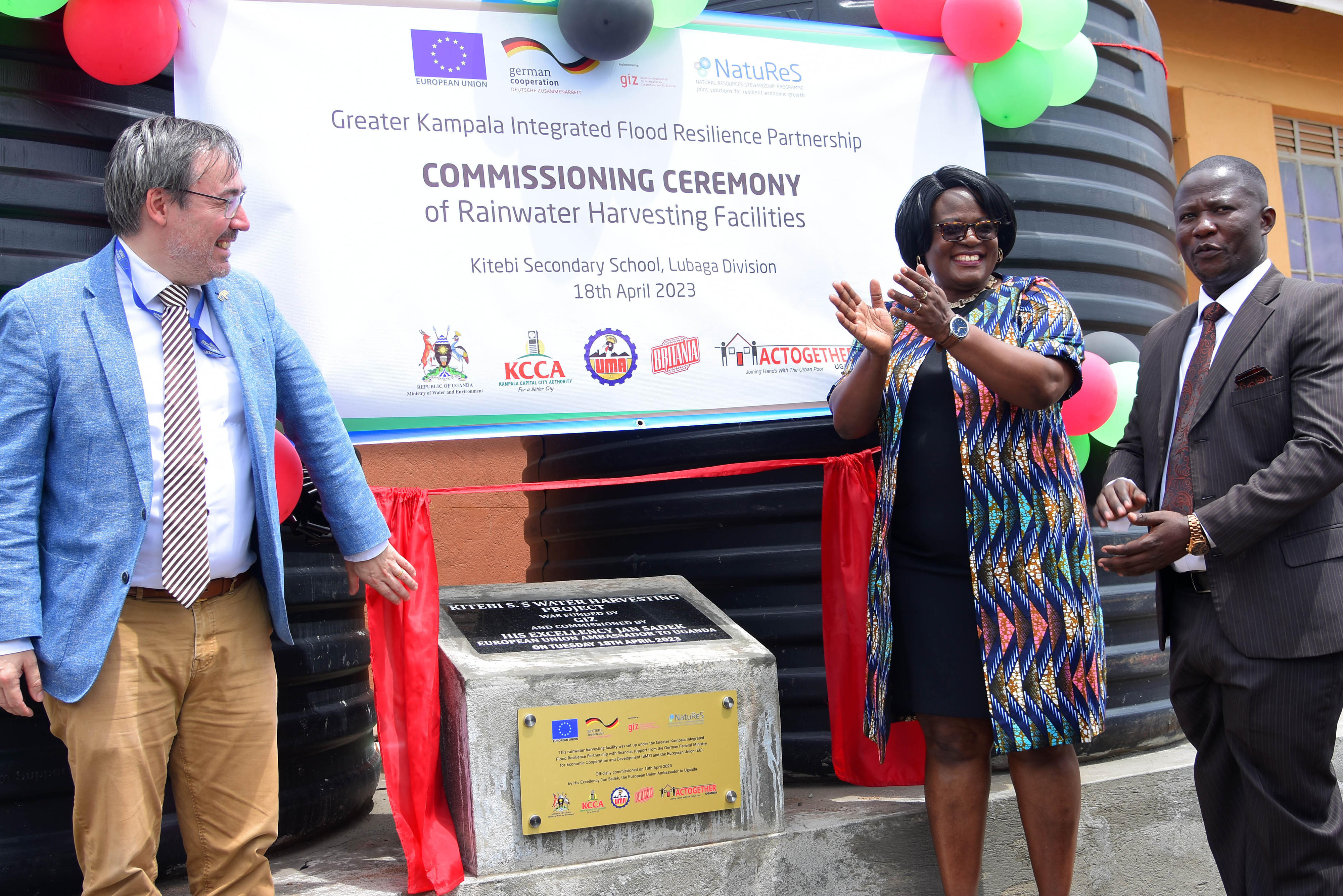Water harvesting tanks reduce school absenteeism, save Kisoro women from abuse

Women fetch water from one of the community water tanks in Gitendere Village in Kisoro district. PHOTOS/ ROLAND NASASIRA
What you need to know:
- Statistics from the ministry of water and environment indicate that at least 14 million Ugandans (about 30 per cent of the population) do not have access to clean and safe water services.
- With funding from GVTC, Uplift the Rural Poor constructed 17 communal rainwater harvesting tanks for locals from three parishes of Gisozi, Gitendere and Rukongi, all in Kisoro.
- Each tank carries 30,000 litres and collects its water from a community hall where community meetings are held.
Anna Nyirazihawe, 25, lives at Ndego Village, Nyarusizi parish in Kisoro District in South western Uganda.
Until 2014, like the other households in the village, Nyirazihawe’s was equally affected by acute and severe shortage of water for domestic use. For all the 400 households in the village, each with about six members, the nearest source of water was eight kilometers away from the village in the ponds inside the neighbouring Mgahinga National Park, a daily trek where locals shared the water with wild animals.
“I used to leave home at 7am with other women and be back at 3pm more over hungry yet I had to prepare meals for my family. While fetching water, park rangers would run after us because it was illegal to enter the park but we had no choice. On several occasions, I would be among those arrested and beaten. At times we would fall and get injured as we ran from the rangers,” the mother of five narrates.

“My husband always left home every morning and only returned to eat and sleep. When he didn’t find water, he would shout and threaten to beat me. I use three jerrycans of water each day in my home. If I was to have enough water for home use, I wouldn’t do any other domestic work but my husband wouldn’t understand. I couldn’t send children to fetch water because they were young,” Nyirazihawe recalls.
Amos Nsekanabo, the Local Council one (LC1) Secretary of neighbouring Rudantegye village in Gitendere parish, Nyarusizi Sub County in Kisoro district narrates that from a communal basis, Nyirazihawe’s ordeal is not any different from that of other women from his village which has over 150 households, each with about 10 members.
“Before the rain water harvesting tanks were built, locals fetched water from the park. While there, some of them, especially girls would be raped. Some of them contracted syphilis, HIV/AIDS and unwanted pregnancies. The water from the park was dirty and some locals contracted diarrhea from using it,” Nsekanabo recalls.
The real problem
In 2010, Uplift the Rural Poor (URP), a community based organisation carried out a community based planning study around Mgahinga and water emerged as the biggest challenge in all homesteads. It was from their findings that the organisation received support from Greater Virunga Transboundary Collaboration (GVTC) to construct rainwater harvesting tanks for communities around Mgahinga under the water for Virunga project. The project is not only aimed at promoting safe water access to communities around the park but also stopping the locals who encroached on the park for water and illegal activities such as poaching.

Part of Mgahinga National Park where locals in Kisoro fetched water before acquiring community tanks
“The water from ponds in the park was always dirty because locals shared it with wild animals. There were raised concerns of animals attacking and killing locals while fetching water. In the communities, women were occasionally harassed by their husbands. Whenever there was no water in homes, men would turn to women and beat them. Men don’t participate in water issues because culturally, they believe that fetching water is for women and children,” says Jack Rutunda, a Field Officer with Uplift the Rural Poor.
With funding from GVTC, Uplift the Rural Poor constructed 17 communal rainwater harvesting tanks for locals from three parishes of Gisozi, Gitendere and Rukongi, all in Kisoro. Each tank carries 30,000 litres and collects its water from a community hall where community meetings are held. The tanks are maintained by village committees. In case of any damages, the committee calls for a village meeting to discuss ways of maintaining the tanks for sustainability.
What local leaders say
Philemon Bitariho, the LC1 chairperson of Ndego village says before construction of water tanks, his constituents like Nyirazihawe would sometimes walk long distances for water but still go back to their homes with no water. School going children never washed their uniforms because there was no water in all homes.
“The locals no longer walk to the national park because they now have alternative water sources in form of communal tanks. School children are able to wash their uniforms but also attend school. Absenteeism from schools has significantly reduced,” Bitariho says.
According to Bitariho, the challenge at hand is the growing population yet the number of water tanks has remained the same. There’s free land where more water tanks can be built, yet the water for Virunga project ended in 2015.

A woman fetches water from one of the community water tanks in Gitendere Village in Kisoro district. PHOTOS/ ROLAND NASASIRA
Statistics from the ministry of water and environment indicate that at least 14 million Ugandans (about 30 per cent of the population) do not have access to clean and safe water services.
About Greater Virunga landscape
Greater Virunga landscape is made of seven national parks and one wildlife reserve. These include Mgahinga Gorilla, Queen Elizabeth, Bwindi, Rwenzori Mountain and Semliki national parks respectively in Uganda; Volcanoes national park in Rwanda and Virunga national park and Sarambwe Wildlife Reserve in DR Congo.
The landscape covers the central part of the Albertine Rift that straddles the borders of Democratic Republic of Congo, Rwanda and Uganda and is one of the most diverse landscapes in the world and is the world’s hotspot for biodiversity conservation.




